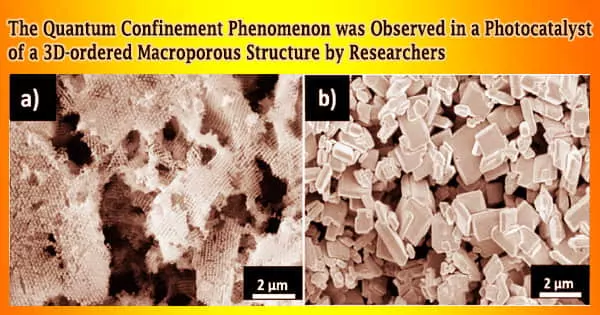Because hydrogen is a high-energy-density fuel, green hydrogen production from solar water splitting has piqued interest in recent years. The quantum confinement phenomenon was discovered in a photocatalyst of a 3D-ordered macroporous structure by a research team lead by academics from the City University of Hong Kong (CityU) and Germany.
Under visible light, the quantum confinement phenomenon was discovered to permit hydrogen synthesis. The findings suggest a way to address energy and environmental issues.
The research was co-led by Dr. Ng Yun Hau, Associate Professor in CityU’s School of Energy and Environment (SEE), and researchers from Germany.
“Unveiling Carrier Dynamics in Periodic Porous BiVO4 Photocatalyst for Enhanced Solar Water Splitting,” their findings were published in the scientific journal ACS Energy Letters.
The new hydrogen-producing function of oxygen-producing photocatalyst
According to Dr. Ng, a photocatalysis expert, a conventional photocatalyst for solar water splitting can only absorb ultraviolet light from the solar spectrum, which accounts for roughly 4% of the energy from sunshine. Bismuth vanadate (BiVO4), a metal oxide photocatalyst that can absorb up to 30% of the energy in the solar spectrum, can absorb both ultraviolet and visible light.
BiVO4, in general, cannot produce hydrogen because of its position of the conduction band. Now thanks to the quantum confinement effect, which raised its conduction band, hydrogen can be produced. This is also the first time that the quantum confinement effect was found in 3DOM BiVO4.
Dr. Ng Yun Hau
Because of its improved performance, BiVO4 in a 3D-ordered macroporous (3DOM) structure has gotten a lot of interest. The greater surface area, high light absorption, and less charge recombination are frequently credited for this structure’s better photocatalytic capabilities.
However, no systematic studies on the effect of charge transport in highly ordered porous nanostructures on photoactivity have been conducted. Dr. Ng and his team took on this task and looked into the differences in carrier dynamics between 3DOM and plate-like BiVO4 samples, as well as their photocatalytic efficiency.
The researchers discovered that the 3DOM BiVO4 photocatalyst produces nearly twice as much oxygen as the plate-like BiVO4 photocatalyst in the water-splitting process under visible light.
Furthermore, the anodic photocurrent density of the 3DOM BiVO4 photocatalyst was higher than that of the plate-like form. As a result, the photocatalysis efficiency of 3DOM BiVO4 is greater.
“To our surprise, BiVO4, originally an oxygen-producing photocatalyst, also produced hydrogen during water splitting under visible light when it was in the 3DOM structure. This had never previously been reported,” said Dr. Ng.
Quantum confinement effect discovered
How does BiVO4 create hydrogen in a 3DOM structure? One of the study’s highlights was given by Dr. Wu Hao, the paper’s first author and the energy stream leader at Dr. Ng’s group.
“We discovered that quantum confinement arising from the ultrathin, crystalline wall of 3DOM BiVO4 raised its conduction band. It enables photocatalytic proton reduction to hydrogen under visible-light illumination, allowing hydrogen to be generated from water splitting.”
When the size of a material is lowered to the nanoscale, quantum confinement refers to changes in electrical and optical properties such as energy levels and band gaps.
“BiVO4, in general, cannot produce hydrogen because of its position of the conduction band. Now thanks to the quantum confinement effect, which raised its conduction band, hydrogen can be produced. This is also the first time that quantum confinement effect was found in 3DOM BiVO4,” Dr. Ng explained.
The researchers also revealed that 3DOM BiVO4 can manufacture hydrogen from liquids under visible-light illumination without the use of a co-catalyst, whereas plate-like BiVO4 produced very little hydrogen.
A co-catalyst is a material that aids the catalyst’s function. It can help charge separation by providing accumulating sites for photo-generated charges. The scientists also used advanced techniques to analyze BiVO4 photocatalyst in 3DOM and plate-like structures, including time-resolved microwave conductivity.
They discovered that 3DOM BiVO4 has about six times better charge mobility, nearly 18 times longer charge carrier lifespan, and about nine times longer effective diffusion length than plate-like structure, boosting photocatalysis efficiency.
Next goal: waste-water splitting
This research is an important step toward better understanding charge transport in metal oxide semiconductors and highly organized porous structures. Dr. Ng and his team’s next goal is to separate wastewater and look into ways to scale up photocatalytic devices.
“Hydrogen produced from solar water splitting is a green process without any carbon emissions,” said Dr. Ng. “Hydrogen can be used for industrial purposes and in fuel cells for electricity. We expect this technology to have a wider application in the future, as there is high demand for producing hydrogen from green resources.”
The paper’s corresponding authors are Dr. Ng and Dr. Fatwa F. Abdi of the Helmholtz-Zentrum Berlin (HZB) for Solar Fuels. Dr. Wu Hao, a Postdoctoral Fellow in CityU’s SEE, is the first author. Dr. Chung Hoi-ying, a postdoctoral researcher in the SEE, also took part in the study.
HZB and the Beijing University of Technology are among the other collaborators. The Hong Kong Research Grants Council and the Shenzhen Science and Technology Innovation Commission funded the study.





